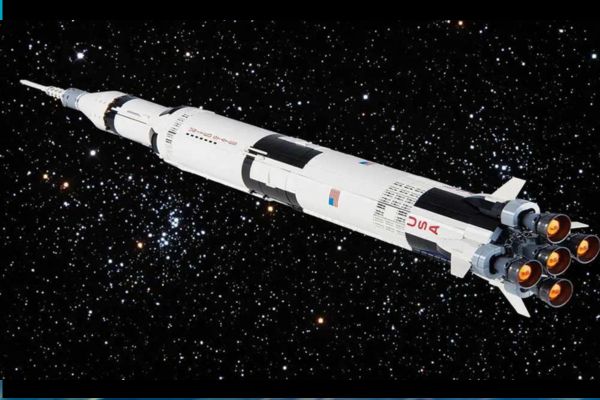Space exploration has always captured the imagination of humanity, pushing the boundaries of what is possible and offering glimpses into the vast unknown.
Witnessing the Earth from space fosters a deep appreciation for our planet’s beauty and its interconnectedness. It instils a sense of unity and a realisation that we are all inhabitants of a fragile world.
Beyond the technical marvels and scientific breakthroughs, the experience of space travel offers a profoundly transformative perspective. The three spacecraft discussed in this article represent pivotal milestones in space exploration.
One of the most iconic and powerful spacecraft ever built, the Saturn V rocket played a crucial role in NASA’s Apollo missions during the 1960s and early 1970s. It stands as the tallest, heaviest, and most powerful rocket in history.
The Saturn V, with a cost of approximately $189 million per launch — in the time frame from 1969 to 1971; equivalent to $1.06 billion–$1.09 billion in 2021–, was instrumental in propelling astronauts to the Moon, marking a significant milestone in human space exploration. Its impressive height of 363 feet (110 meters) and powerful engines enabled it to carry a maximum payload of over 118 tons (107 metric tons).
The Space Shuttle, developed by NASA, revolutionised space travel by introducing a reusable spacecraft system. It consisted of an orbiter, two solid rocket boosters, and an external fuel tank.
Launching the Space Shuttle, which weighs about 2,000 tonnes, cost about $800 million USD, or nearly a billion dollars. Including other expenses, the total average cost per Space Shuttle flight is about $1.5 billion USD.
Constructing the Space Shuttle orbiter alone took about six years. The Space Shuttle program spanned from 1981 to 2011 and featured numerous missions, including the deployment of satellites, conducting scientific experiments, and construction of the International Space Station (ISS).
Developed by SpaceX, the Falcon Heavy is a modern marvel in spaceflight. With its impressive liftoff thrust, the Falcon Heavy can deliver a payload of up to 64 metric tons (141,000 pounds) to low Earth orbit.
This capability opened up possibilities for deep space exploration and the potential for commercial ventures beyond our planet. SpaceX has utilized the Falcon Heavy for missions like launching satellites and test flights, paving the way for future human missions to destinations such as Mars.
Falcon Heavy costs an estimated cost of $90 million per launch.
In addition to their impressive facts, figures, costs, and timelines, these spacecraft incorporate groundbreaking technologies that took space exploration to new heights.
The Saturn V rocket employed F-1 engines, the most powerful single-chamber liquid-fueled rocket engines ever built. Its guidance system relied on advanced inertial navigation and control systems, enabling precise trajectory calculations and adjustments during the mission. The rocket also incorporated cutting-edge materials and manufacturing techniques to withstand the extreme conditions of space travel.
Space Shuttle introduced the development of the thermal protection system, which used advanced ceramic tiles to shield the orbiter from the intense heat experienced during reentry. It also pioneered the use of a reusable spacecraft system, allowing for multiple missions and reducing the overall costs of space travel. In addition, the Space Shuttle featured advanced computer systems, flight control systems, and avionics, improving the way astronauts interacted with the spacecraft.
The Falcon Heavy showcases a range of innovative technologies as well. One standout advancement is the utilization of advanced propulsion systems, including the Merlin engines, which offer exceptional thrust and efficiency. It incorporates advanced guidance, navigation, and control systems that enable precise landing and reusability of its booster stages. Furthermore, Falcon Heavy integrates advanced manufacturing techniques, such as 3D printing, to enhance efficiency and reduce production timelines.
Space travel pushes the boundaries of human capabilities and fuels our innate curiosity to explore the unknown. By venturing beyond our planet, we gain a profound understanding of our place in the universe and inspire future generations to continue pushing the boundaries of human achievement.
How was your literal journey to space?
Read more on SpaceX, Vast collaborate to launch world’s first commercial space station







![RJ Scaringe, Rivian founder and CEO [source MarketWatch]](https://autojournal.africa/wp-content/uploads/2025/11/RJ-Scaringe-Rivian-founder-and-CEO-source-MarketWatch-350x250.png)
![Bentley GTA VI delayed [source MarketWatch]](https://autojournal.africa/wp-content/uploads/2025/11/Bentley-GTA-delayed-source-MarketWatch-350x250.png)
![F1 Sao Paulo Grand Prix Brazil 2025 [source Autoevolution.com]](https://autojournal.africa/wp-content/uploads/2025/11/F1-Sao-Paulo-Grand-Prix-Brazil-2025-source-Autoevolution.com_-350x250.png)
![Air crashes in 2025 [source The New York Times]](https://autojournal.africa/wp-content/uploads/2025/11/air-crashes-in-2025-source-The-New-York-Times-350x250.png)










